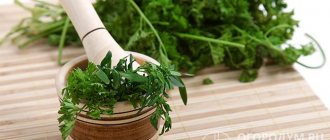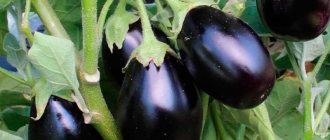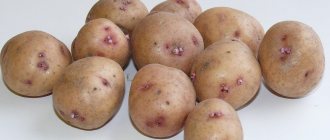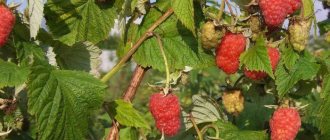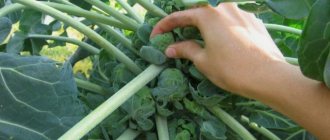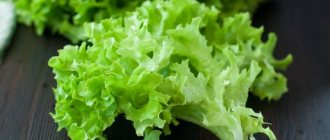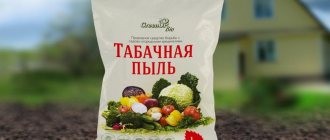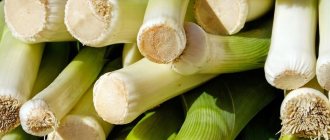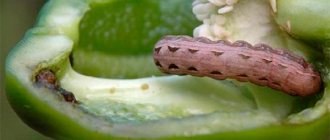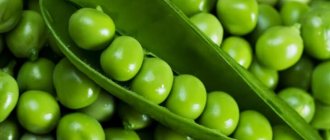Coriander, or cilantro - description of the plant
Many people are mistaken in believing that coriander and cilantro are different plants. In reality, they are just different parts of the same crop: cilantro is a green, and coriander is a seed. Perhaps the difference in names comes from the fact that these components have different tastes and aroma. In general, the plant is most often called coriander. Although in different areas you can find other names: Chinese parsley, Mexican parsley, calandra, shlondra, kinji, chilantro, etc. In appearance, coriander is similar to ordinary parsley, but it has a specific taste.
The leaves of parsley and coriander are similar in shape: on the left are coriander greens, on the right are parsley
There are many versions of the origin of the name of the plant. Folk etymology derives it from the ancient Greek κόρις, which means “bug”. Indeed, the greenery has a pungent aroma, somewhat reminiscent of the smell of a bug, due to the high content of a special substance (decylaldehyde) in the essential oil of the plant’s leaves. During the drying process, this smell disappears almost completely; ripened seeds contain only its remnants.
A little history
The supposed homeland of the culture is the eastern coast of the Mediterranean Sea. According to historical information, coriander appeared in Europe even before our era during the Roman conquests. For example, in the south-eastern counties of Great Britain it is still common as a weed. During the era of great geographical discoveries, Europeans brought culture to the American continent, as well as to Australia and New Zealand.
In Russia, coriander was first mentioned in the 18th century, and the beginning of mass cultivation of the crop is associated with the name of Count P.I. Apraksin, who brought the seeds of the plant from Spain and ordered the peasants of the village of Krasnoye, Voronezh province, to grow the crop.
Now coriander is cultivated everywhere, not only on personal plots, but also on an industrial scale.
In many regions, coriander is cultivated to obtain essential oil; in addition, the plant is an excellent honey plant.
Description and main characteristics
Coriander is an annual herbaceous plant belonging to the Umbelliferae family:
- simple and pinnately dissected leaves grow on an erect stem with a branched upper part;
- plant height ranges from 40–70 cm;
- The culture blooms in June - July with small white or pinkish flowers collected in inflorescences;
- by the end of summer, in place of the flowers, seed umbels with spherical hard seeds with sinuous or straight ribs are formed;
- Fruits ripen by mid-September in northern latitudes, and in the south - about a month earlier.
Photo gallery: greens, flowers and coriander seeds
Coriander fruits are small, hard, ribbed balls.
Coriander flowers are arranged in the form of umbrellas at the ends of the flower stalks
Cilantro has unequal leaves along the stem: the lower ones have petioles, and the upper leaves sit directly on the stem, the latter have a slightly elongated shape
Application, benefits and harm of coriander
The leaves, seeds and roots of coriander are used in cooking. Dried and crushed seeds are usually added to confectionery products, cheeses and sausages, and used in the preparation of meat and fish dishes and soups. This unique plant gives a special taste not only to food, but also to drinks. The spice, for example, is included in the recipe for the well-known Borodinskaya tincture and in the original Macedonian liqueur.
There is no point in storing ground plant seeds, since the powder quickly loses its taste and aroma. It is better to harvest whole seeds. Before use, they are lightly fried in a dry frying pan and only then crushed.
Coriander seeds will not lose their flavor if crushed before use.
Cilantro - the greenery of the plant - is not recommended to be cooked. It is added to various dishes, including salads. Ground coriander roots have a more muted flavor than green leaves. Most often they are used in sauces for meat and fish dishes. The flavor of the root goes well with garlic, peanut butter and pepper.
Coriander oil and extract are widely used in cosmetology. They are included in various creams, tonics, lotions for skin and hair care. Interestingly, in addition to the anti-inflammatory, whitening and rejuvenating effect, a weak concentration of coriander oil can give products the aroma of a rose or lily of the valley. Coriander oil is popular in aromatherapy and soap making.
Concentrated coriander oil has a yellowish color, a pungent odor and a bitter taste.
The wide use of the plant, including in pharmacology, is explained by its unique chemical composition: high content of dietary fiber, organic acids, starch, vitamins, macro- and microelements. Coriander is capable of:
- relieve spasmodic pain;
- improve digestion, relieve heaviness in the stomach after heavy meals;
- suppress the development of malignant tumors;
- maintain eye health;
- stop bleeding;
- remove toxins from the body;
- fight infections and germs.
Coriander seeds and greens should not be consumed by people with individual intolerance to the plant, with circulatory problems, as well as with diabetes and hypertension.
Features of coriander
Cilantro is a herbaceous annual plant. The shape of the root is spindle-shaped, the height of the bare erect stem varies from 0.4 to 0.7 m, which branches in the upper part. The basal leaf plates are long-petiolate, coarsely dissected, tripartite, with wide lobes, and their edge is incised-serrate. The lower stem leaves are short-petiolate, doubly pinnately divided, while the upper and middle ones are vaginal, pinnately dissected into linear lobules. At the tops of the peduncles there are umbrella inflorescences, which include 3–5 rays, consisting of white or pink small flowers. The fruits are ribbed, hard, ovoid or spherical fruits. Flowering is observed in June–July, the time of fruit ripening depends on the climate and is observed in July–September. The seed remains viable for 2 years. The fragrant greenery is called cilantro and is used in dried and fresh form, while the seeds are used as a spice called coriander.
CILANTRO AND CORIANDER, ARE THEY THE SAME?
Varieties and types of coriander
Before you start planting coriander on your site, you need to decide for what purpose you plan to grow the plant, and, depending on this, select the appropriate variety. When choosing, you should pay attention to the timing of ripening, the yield of greens and fruits, aromatic qualities, and the richness of the color of leaves and seeds. The State Register of Breeding Achievements approved for use on the territory of the Russian Federation includes 13 varieties of this plant. Three of them (Medun, Mius and Ranniy) are recommended for cultivation in the North Caucasus region, the rest have no restrictions on the growing area.
Table: coriander varieties included in the State Register of Breeding Achievements
| Variety name | Growing season, days | Description | Seed yield g/m2 | Peculiarities |
| Chord | 109 |
| about 100 |
|
| Alekseevsky 190 | 89–91 |
| about 150 |
|
| Alekseevsky 413 | from 66 |
| from 120 |
|
| Aroma | 109 |
| from 60 |
|
| Medun | N/A | Compact plant with an erect stem up to 115 cm high | about 220 |
|
| Mius | N/A |
| from 110 | Drought resistant |
| Nectar | 30–40 | Branched bush up to 90 cm high | N/A |
|
| Early | 30–50 | A highly branched plant about half a meter high with large dark green leaves and a persistent, strong, spicy aroma | about 150 |
|
| Light | 100–110 |
| from 100 | Weakly affected by ramulariasis |
| Strongman | 251 |
| from 220 |
|
| Eva | 35–45 | Semi-closed bush about 60 cm high with a stem of medium thickness | about 140 |
|
| Gialos | 107 |
| from 130 |
|
| Amber | 40–45 | Compact bush, about 50 cm high | about 150 |
|
Photo gallery: domestically selected coriander varieties
Coriander Alekseevsky 190 is grown directly to obtain a harvest of mature seeds
Coriander of the Yantar variety is distinguished by good foliage, slow bolting, and high aromaticity
The main qualities of the Medun variety are resistance to ramularia, increased winter hardiness, and the ability to grow during winter and spring sowing periods.
Coriander Mius - variety for spring sowing
Nectar is a variety suitable for winter and spring sowing periods
Coriander variety Early is a fast-growing leaf variety.
Coriander Light is a mid-season variety with juicy leaves of increased aromaticity
Varieties of cilantro
Below we will describe those varieties of coriander that are most popular among gardeners.
- Caribe . This hybrid Dutch variety appeared relatively recently. The bushes have a lot of foliage, which has a strong and pleasant smell. This annual plant is frost-resistant. Its leaves are very tender, and they are used as a seasoning for first and second courses, as well as salads, and the seeds are used in the preparation of confectionery and marinade.
- Amber . The variety is characterized by slow bolting. The bushes have a large number of very fragrant leaves. This plant contains many essential oils; its greens are added to first and second courses, as well as to salads, while the seeds are used in the preparation of sausages, confectionery and marinades.
- Borodinsky . This medium-ripening variety can be consumed fresh, and seasonings can also be prepared from it. The taste of this coriander is very pleasant and the smell is subtle.
- Debut . This medium-ripening variety is resistant to stemming. It is used in the preparation of marinades and various dishes.
- Stimulus . Medium late variety. The bush has a compact rosette consisting of dark green shiny leaf plates; it reaches 25–30 centimeters in diameter. This cilantro can be added to meat dishes, salads and soups.
- Venus . This late-ripening variety has a raised rosette of leaves. The greens have a pleasant taste and exquisite aroma; they are added to salads and used to decorate various dishes; the seeds are used to flavor bread and confectionery, and also in the preparation of marinades.
- Taiga . A late-ripening spicy variety that has a large amount of richly colored foliage, they have an unusual smell. The seeds are used as a seasoning, and the greens are added to a variety of dishes.
- Vanguard . This mid-ripening variety is low-growing. The leaf rosette is raised and has a strong odor. The seeds are added to marinades, and dried and fresh leaves are added to a variety of dishes.
Also popular are the following varieties of cilantro: Alekseevsky, King of the Market, Early, Kirovogradsky and Oktyabrsky.
Growing coriander in open ground
Coriander is a cold-resistant plant. Its seedlings can withstand frosts down to –5 °C, so sowing can begin early, as soon as the soil thaws. Choose a sunny place for the culture. In a shaded area, it produces little greenery, quickly throws out flower stalks, and the fruits grow small and take a long time to ripen. An exception may be sparse shade from trees and shrubs. The ideal soil for coriander is slightly alkaline or neutral, nutritious, with good air and moisture permeability. During autumn digging, it is filled with organic matter and a potassium-phosphorus complex (40 g per 1 sq. m).
It is best to allocate a place for coriander where beets, corn or legumes grew last season.
Planting in a garden bed
Seeds can be used either your own or purchased. It should be borne in mind that they remain viable for 2–3 years. Seeds most often do not require soaking or pre-sowing preparation. Sowing coriander is completely standard:
- In the spring, the soil on the site is thoroughly loosened, and nitrogen fertilizers are applied if necessary.
- Make grooves in the garden bed at a distance of at least 20 cm from each other and spill them with water.
For 1 sq. m to obtain green cilantro, sow 2–2.5 g of seeds, and 1.5–2 g for seeds
- Seeds are sown sparsely, every 8–10 cm from each other. To ensure the quality of seedlings, you can put 2 seeds in one place and remove weaker seedlings during the growth process.
- The sowing depth is kept to about 1.5 cm. Although some gardeners advise planting deeper, assuring that in this case the plant is less susceptible to disease.
- After sowing the seeds, water the bed abundantly.
Seeds begin to germinate at soil temperatures of +6 °C. After 5–20 days, shoots will appear. Germination time depends on the variety, timing and storage conditions of seeds, and weather conditions.
Many varieties of coriander can be sown in autumn. In this case, the harvest is more abundant than when sowing in spring.
The fresher the seeds are, the stronger and more friendly shoots they will produce.
To constantly have fresh greens, the seeds are sown in stages every 2-3 weeks, starting in April and ending in mid-summer. Such sowing will allow the same area to be used for cultivation, provided that the greenery is cut before the bud-laying phase. Please note that when reusing soil, it must be fertilized with nitroammophos or superphosphate.
Coriander care
Caring for the crop is not at all difficult.
After 2–3 true leaves appear on the plant, the plantings are thinned out. The distance between growing seedlings must be at least 10 cm, otherwise the coriander will quickly bloom. Please note that removed plants are not replanted. Cilantro has poorly developed adventitious roots, so even slight damage to the central taproot will lead to the death of the seedlings.
A bed with coriander before thinning (photo on the left) and after (photo on the right)
To prevent cilantro from being choked by weeds and from sprouting peduncles due to lack of light, it is necessary to regularly and thoroughly weed the garden bed, as well as systematically and abundantly water it. With a lack of moisture, young plants can also begin to bloom. The amount of watering is reduced to a minimum only during the period of fruit ripening. After each watering, the row spacing must be loosened. If there is not enough air in the soil, the coriander will produce little greenery and quickly throw out its inflorescences.
During the period of active growth, feeding the crop is not recommended. All fertilizers must be applied in advance - during autumn and spring digging of the soil.
Harvesting greenery and preparing seeds
Cilantro is cut when the plants reach a height of 14–15 cm, and some of them can move from the stemming phase to the budding phase. It is better to clean it in the morning and make the cut near the ground. After cutting, coriander does not grow back.
Coriander greens should be collected before discarding the flower baskets.
Cut greens are washed and laid out or hung to dry in a dry and dark room. Drying in the light leads to the loss of many beneficial qualities of cilantro. If you plan to chop the herb, you should do this after it is completely dry, as cutting fresh cilantro will also result in the loss of beneficial essential oils.
After drying, it is recommended to store the spice in tightly closed containers.
If the coriander has bloomed, then its greenery becomes scarce, becomes rough and tough. In this case, it is better to leave the plant alone until the seeds ripen. In moderate climates, coriander sown in late April will bloom in July. The flowering period lasts about 40 days.
Ripe coriander seeds have a unique spicy smell, while the smell of green fruits is, to put it mildly, unpleasant
In September, most of the seeds should turn brown. At this time, the umbrellas are cut, tied into bundles and hung to dry. You need to spread a film or clean cloth under them for easy collection of crumbling seeds. After the color of all the seeds changes to brown, and the taste and aroma become characteristic of coriander, they are shaken out of the boxes and sifted, separating them from the remains of the herb. The collected seeds should be stored in glass containers with a lid.
Caring for cilantro in the garden
The agricultural technology for growing cilantro is not complicated and is similar to growing parsley. The plant needs watering, loosening and fertilizing. In order for the greens to grow lushly, the plantings also need to thin out the sprouts, otherwise the leaves will be thin and pale green. Thinning is done at the two-leaf stage, leaving 5 cm between plants.
Watering should be regular, especially during periods of intensive growth. Water at least 2 times a week, using 4-5 liters of water per 1 square meter. m. In hot weather, the frequency of watering is increased, in cool and cloudy weather, on the contrary, it is reduced. It is better to water the plants at the roots. The best time for watering is in the evening, when the sun is setting and cannot burn the leaves with its rays.
Before cutting cilantro for eating, it must be well watered. After abundant watering, the smell and richness of the leaves are completely different. The grass becomes tastier and more aromatic.
If you plan to grow coriander for seeds, then in the second half of the growing season, watering is reduced to 2 liters per 1 square meter. m. This stimulates the release of peduncles and early ripening of seeds. After watering, the soil must be loosened to break up the earthen crust, which prevents the passage of air to the roots of the plant.
Blooming cilantro (coriander)
When a large green mass grows and the plant blooms, it requires more nutrients. Therefore, feeding him is extremely important. They are carried out in the fall or spring before planting, when the beds are prepared. In order to support and feed the plant, vermicompost is best suited for feeding. To do this, just sprinkle a handful of vermicompost under the root of the plant. At the same time, you can weed the weeds. After fertilizing, be sure to water the plants at the roots.
If the plant is planted only for growing greens, and you do not need the seeds, when the first flower stalks appear, they must be broken off before they grow too much. Otherwise, the greens will become coarser, and the leaves will become pale green and lose their juiciness.
Growing cilantro in a greenhouse
To obtain an early harvest of cilantro, the crop can be planted in protected soil. Plant seeds are planted in a greenhouse as soon as the soil warms up. Sowing and caring for coriander in a greenhouse does not differ from agricultural techniques for growing it in open ground. During the season, crop seeds can be planted in a greenhouse several times, both in separate ridges and as a neighbor plant between rows of other crops. Considering that many pests do not like the smell of spice, including the Colorado potato beetle and aphids, such a neighborhood will be useful.
If you plant coriander in a heated greenhouse, you can harvest greenery all year round. Moreover, it is recommended to plant plants not only directly on the ridges, but also in boxes and pots installed on racks. Such cultivation is possible if the greenhouse has:
- competent heating system;
- additional lighting;
- water supply system for watering plants.
If a sufficient amount of fertilizer is initially added to the soil, care in this case will consist of thinning, weeding, watering and loosening the soil.
For year-round cultivation of coriander, permanent buildings are needed, covered with double plastic film, tempered glass or polycarbonate sheets.
In protected soil, coriander is grown to produce greenery, so it is important to cut the bush as soon as it reaches a marketable height of 10–20 cm. If coriander is sown in January-February and, therefore, the greenery is harvested early, when cutting, you can leave the stems tall up to 7 cm. They will give a second harvest, which, however, will not be as abundant as the first. If the plant is planted later, the effect of double harvesting will not be achieved - the leaves will not grow, and the remaining stem will simply dry out.
Planting dates taking into account the conditions of different regions
Cilantro is a cold-resistant plant that can withstand temperatures down to -5°C, so it can be sown in open ground in early spring, as soon as the snow melts and the soil warms up to 6-8°C. In the central zone, the time for planting cilantro is in April, in the south it is possible to sow earlier - in March, in the northern regions - in the 1st half of May.
It should be taken into account that it is better to plant early rather than late; with late sowing, the plants will not be as lush; the flower stalks will be thrown out earlier (3 weeks after germination). Cilantro can be sown with seeds a second time during the season - in August, when the days become shorter again, and even before winter. With pre-winter sowing, young greenery should appear already in March. In greenhouses, it is permissible to plant coriander in late February - early March, while the greens can be harvested at the end of April. In greenhouses, seed sowing can be carried out several times per season.
Homemade coriander greens
If your family really loves cilantro, then it is quite possible to set up a continuous conveyor for growing spicy herbs. Starting in May, its harvest can be harvested in a greenhouse; in the summer it will bear fruit for a long time in the open ground if the seeds are sown in stages. Then you can use a heated greenhouse, and in its absence, you can successfully grow cilantro on a windowsill. For this you will need:
- seeds that you collect on your site or purchase in a store;
- planting containers - their size depends on the amount of greenery you plan to grow: a flower pot is quite suitable for 3-4 bushes. It is better to choose ceramic containers - they are more breathable than plastic ones. To grow more greens, you can use seedling containers or wooden boxes. A drainage layer should be arranged in containers to prevent moisture stagnation;
- soil - garden soil is quite suitable if it has such properties as nutritional value, looseness and moisture permeability. Garden soil can be mixed with purchased universal soil;
- sunny place - the greens of cilantro will be juicier and brighter if you can provide it with enough light. The best place for the plant would be a south-facing window sill.
Cilantro on the windowsill will not only decorate the interior, but will also be a storehouse of the maximum content of useful substances when freshly picked.
Sowing is carried out in small holes or in lines:
- Leave a gap of at least 5 cm between plants. Planting should not be thickened, as this will lead to the seedlings being stretched out.
- Seeds are planted to the same depth as when sown in open ground.
- The planting container is covered with film or glass.
- Before sprouting, the shelter is raised daily for ventilation, and immediately after sprouts appear, it is removed.
This is followed by standard care: thinning, watering and loosening the soil as necessary. The main features of growing cilantro at home are as follows:
- plants will need additional lighting to prevent stretching;
- When harvesting, the bushes are not cut at the root, but the required number of leaves are plucked;
- You need to regularly remove flower arrows - this will help extend the period of harvesting greenery. Changes in taste and hardness indicate that cilantro is unsuitable for consumption.
Following these rules will allow you to get your favorite spicy herbs literally a month after sowing, and they will be just as tasty and aromatic as from the garden.
Brief description of cultivation
- Landing . To grow indoors, seeds are sown from early to mid-March, and they are sown in open soil in May–March.
- Illumination . Shaded or well-lit area.
- Soil . Sandy or loamy soil, which should be slightly alkaline or neutral.
- Watering . Crops must be watered abundantly and systematically. When seedlings appear, watering should be reduced, and the soil on the site should always be slightly damp. After the bushes begin to actively grow green mass, they must again be watered abundantly, otherwise they will begin to bloom. During fruit ripening, cilantro should be watered sparingly again.
- Fertilizer . If the necessary fertilizers were added to the soil before sowing, then there is no need to feed the bushes.
- Reproduction . Seeds.
- Harmful insects . Seed-eaters, umbrella and striped bugs, winter cutworms and their caterpillars.
- Diseases . Ramularia, rust and powdery mildew.
- Properties . The greens of this plant have antiscorbutic, analgesic, diuretic, anthelmintic and expectorant effects. Cilantro fruit is a popular spice.
Possible problems when growing coriander
Coriander is a persistent crop. It has few pests, but in unfavorable circumstances you should be prepared to fight them. The main thing is to periodically pay attention to the appearance of the plant. This will allow you to see the problem in a timely manner.
The main weapon in the fight against all diseases of coriander is prevention and compliance with agrotechnical rules.
Table: coriander pests and measures to combat them
| Pest | Signs of defeat | Harm | Control measures |
| Coriander seed eater |
| Damages the inside of the seed. As a result, it loses viability and weight |
|
| Aphid | Small green, black or gray insects on cilantro leaves, as well as traces of their activity - a sticky sticky coating | Feeds on plant sap, weakens it, and can lead to death |
|
| Striped bug, or line bug | A large insect about 1 cm long with a red scutellum and longitudinal black stripes on the stems and leaves of coriander | It feeds on the milk of unripe seeds, piercing the shell and sucking out the insides. Damaged seeds die before ripening |
|
| Umbrella moth |
| Caterpillars damage the leaves, inflorescences and fruits of the plant, entwining them with cobwebs |
|
Cilantro is an unpretentious plant and, with proper care, resistant to diseases, but sometimes, under unfavorable growing conditions, it is still affected by ramularia and root rot. The fruits may turn black. If you are careful, you can always notice a plant disease in time and eliminate it.
Table: main diseases of coriander and methods of combating them
| Disease | Signs of defeat | Fighting methods |
| Ramulariasis | Brown spots with a dark crimson halo on the leaf blades. Gradually they lighten in the center, merge and cause the leaf to dry out. Affected plants are stunted in growth. Wet and cold weather favors the development of the disease. |
|
| Root rot | Yellowing and drying of leaves, stems, rotting of roots. At the root collar you can see white, pinkish or reddish mycelium |
|
| Bacterial blackening of fruits | A small dimple first forms on the fruit. From it, blackness spreads to the entire fruit (it darkens and dries), to the leaves and stem of the plant. The occurrence of the disease is promoted by high humidity and air temperature within +20 degrees |
|
Photo gallery: main pests and diseases of coriander
The female umbrella moth lays about 200 eggs on the underside of the petioles of coriander leaves.
The striped bug is poisonous and warns all birds and insects about this in advance using its coloring
The striped bug is widespread in the south and central Russia, Siberia, and the Caucasus
A coriander inflorescence damaged by an umbrella moth caterpillar darkens and dries out, and the top of the plant seems to be scorched by fire.
The coriander seed beetle (or coriander wasp) harms coriander, cumin, fennel, anise and some other plants of the umbelliferous family.
Aphids multiply quickly, so the coriander is literally covered in insects
Ramullariasis affects the above-ground organs of coriander (cotyledons, rosette and stem leaves, stems, buds, umbels, flowers, ovaries and fruits) throughout the growing season
Root rot of coriander leads to yellowing and drying of leaves, stems, and rotting of roots
In addition to diseases and pests, coriander has an agrotechnical problem - flowering too quickly. It does not allow the gardener to take full advantage of fresh herbs and deprives the gardener of the beneficial substances that the plant contains. To prevent this from happening, it is important to know the possible causes of the phenomenon:
- incorrect (inappropriate for a particular region) choice of variety;
- growing in the shade;
- dense plantings;
In dense plantings, cilantro blooms too quickly
- lack of moisture;
- poor soil breathability.
To get aromatic greens in sufficient quantities, you need:
- choose the right variety for cultivation;
- plant coriander in an area with sufficient lighting;
- follow the rules of watering and loosening the soil;
- thin out crops in a timely manner;
- when growing at home - provide additional lighting.
Diseases and pests of coriander
Diseases
If you care for coriander incorrectly or do not follow the agrotechnical rules of the crop, the bushes may be affected by rust, ramularia or powdery mildew.
Ramulariasis
Ramulariasis is a fungal disease that actively develops at high humidity, if it is very cold in the summer and heavy dew falls in the morning. This disease can destroy coriander bushes. Brown spots form on the surface of the leaf blades; over time, a pale gray coating appears on them. Externally, the bush looks as if it was burned and dies quite quickly. For preventative purposes, the seed must be treated with a solution of Fitosporin-M before sowing; however, in the area where cilantro grew last year, it cannot be sown this season.
Rust
Another fungal disease is rust, it is very common and can greatly harm a given crop. In the affected bushes, dark-red pustules form on the surface of the leaf blades; they rupture over time, and fungal spores spill out of them, carried by insects or the wind. To prevent the bushes from getting rust, it is necessary to take the same preventive measures as in the fight against ramulariasis.
Powdery mildew
Powdery mildew is also a fungal disease. A whitish coating forms on the aboveground part of the affected plant. Over time, this plaque becomes denser and changes its color to brown. The disease develops most actively in dry and hot weather with sudden changes in temperature and humidity. A large amount of nitrogen in the soil can also contribute to the development of the disease. All diseased bushes must be removed from the soil as soon as possible and destroyed. To get rid of such a disease, if desired, you can resort to folk remedies, which are distinguished by their non-toxicity: the foliage should be treated with a solution of soda ash or fresh mullein, curdled milk or an infusion of fermented weeds.
Harmful insects
The striped bug, the umbrella bug, the seed-eater, and the caterpillars of the winter cutworm can settle on cilantro.
Since experts do not recommend spraying bushes with insecticides, in order to prevent the seed-eater from appearing on the bushes, the seed must be treated before sowing. In autumn, it is imperative to clear the area of all plant debris, and the soil will also need deep digging at this time.
If bugs or cutworm caterpillars appear on the bushes, they will need to be collected manually. If you grow a lot of cilantro, then the bushes can be treated with a solution of wood ash or mustard, and you can also use an infusion of onion peels.
Video: growing coriander
So, we talked about the basic agricultural techniques for growing coriander and provided practical advice. If you have a desire to try growing this wonderful and healthy spice, then we hope our recommendations will help you do this and you will diversify the taste of your dishes and get an additional source of health and beauty.
- Author: Lyudmila Bartasevich
My name is Ludmila. Higher education, graduated from the Minsk Institute of Culture. I live in Belarus. Rate this article:
- 5
- 4
- 3
- 2
- 1
(3 votes, average: 3.7 out of 5)
Share with your friends!
Properties of coriander: benefits and harms
Useful properties of cilantro
The composition of coriander shoots and foliage includes rutin, carotene, vitamins, trace elements and essential oils, and the fruits contain steroid compounds, tannins, sucrose, fructose, glucose, polyphenols, fatty oils, pectin, alkaloids, starch and essential oil. This plant becomes even more useful due to the fact that it contains a mixture of organic acids: linoleic, oleic, isooleic, ascorbic, myristic, stearic and palmitic.
Coriander has antiscorbutic, analgesic, diuretic, anthelmintic and expectorant effects. It helps increase appetite, lower blood pressure, disinfect the gastrointestinal tract, improve intestinal motility and vision, increase potency, stimulate kidney function, and cilantro also helps with insomnia, eliminates swelling and relieves nervous tension, energizes and tones.
The juice of such a culture helps to reduce bleeding gums and strengthen them, eliminate toothache and disinfect the mouth during stomatitis. Greens help cleanse the human body of bad cholesterol and also have a beneficial effect on the functioning of the cardiovascular system. Eating a few coriander leaves can reduce the effects of alcohol and get rid of hangovers.
Coriander - use, treatment of many diseases
Contraindications
Coriander should not be eaten if you have diabetes, coronary heart disease, thrombosis and thrombophlebitis, after a heart attack or stroke, or for pregnant and lactating women. If you eat too much green cilantro, it can harm even a completely healthy person: there is disruption of the menstrual cycle and sleep, as well as weakening of memory. In some cases, when overeating greens, an allergy may appear: pain in the abdomen, vomiting, an itchy rash on the surface of the skin, nausea and upset stool. As soon as the first symptoms of an allergy are noticed, you must immediately take an antihistamine, otherwise complications such as Quincke's edema and anaphylactic shock may appear soon enough.
Storing cilantro
Since we use not only fresh herbs for food, but also dry seeds, we should say a few words about storing cilantro. When dried, green cilantro loses almost all of its flavor. Therefore, it makes no sense to prepare it for future use in this way. But coriander seeds, on the contrary, retain their bright aroma perfectly for many years if you create appropriate storage conditions for them.
For storage, the seeds are thoroughly dried. The complete absence of moisture is the main guarantee of long-term storage of cilantro. Dried seeds are placed in tight containers and hermetically sealed. Plastic bags in 2-3 layers, glass or plastic jars with lids are suitable for this. In this form, coriander seeds can be stored for a very long time without losing their taste and healing qualities. Skillful housewives will always find a use for this amazing plant and its fragrant fruits.
Coriander seeds should be ground into powder immediately before using them, and added to dishes just before the end of cooking. This allows the spice to reveal its aroma most vividly. With prolonged heat treatment, coriander seeds completely lose their aroma. The same thing happens if you store the spice in crushed form, and not as whole seeds.
Using cilantro in your daily diet significantly enriches its taste and helps to avoid many diseases. Therefore, knowing how to plant cilantro, it is worth giving this amazing plant a little time and care by placing it in your home.
Preparing a site for planting cilantro and coriander
How to grow cilantro coriander from seeds How to care
Priming
- For growing cilantro, light loamy or sandy loam soils are preferred.
- The soil must be fertilized: per 1 m², add 2 kg of humus or 30 g of mineral fertilizers for digging.
Illumination of the area
Cilantro grows best in areas well lit by the sun. Slight shading is possible: plant along the fence, near bushes, but not in the shade of trees. Then the sprouts will be stunted and quickly overgrow with flower stalks, which will negatively affect the greenery.
The bed should be on a level area. In the lowlands, cilantro develops slowly and may die from waterlogging.
Predecessors
Good predecessors for the crop will be legumes, cucumbers, cabbage, and potatoes.
Preparing seeds for planting
The seedless method is most often used; it is the simplest. Gives more yield, the plant does not need to get used to the new soil. Growing from seeds on a windowsill can produce quite a lot of greenery.
Box with greenery on the window
- As always, in such cases, the seeds are soaked in water for 3-4 hours, and those that float are removed. These seeds are empty, will not sprout, and it will not be possible to grow a large garden on a windowsill. Soaking is also necessary to swell the shell so that it germinates better.
- The necessary ones are planted in a container. At the bottom there is drainage material, then moistened soil. The depth of planting seeds is 1 cm. Leave 4 cm from the edge of the container, grooves at a distance of 6 cm.
- The seeds are covered with peat on top, which must be sifted so that a crust does not form on top of the soil.
- Seeds require a lot of moisture, so to prevent it from evaporating, the container is covered with film on top.
Preparation and sowing features
To grow coriander in the garden, no special preparatory procedures are required. As an experiment, it is enough to scatter a pinch of grains over the garden bed and cover them with a rake. After a set period of time, strong bushes of fragrant herbal plants grow.
But experimental crops do not always give good results. For planting, you must still comply with all the necessary agrotechnical requirements, since it is better to sow any crop according to certain norms and rules. Only in this case the results of the resulting harvest will not disappoint.
Coriander planting dates
Planting cilantro seeds can be done throughout the warm period. The sowing process is simple and does not require special preparatory work. The plant is unpretentious, and each gardener can determine for himself when to plant the plant and for what purposes.
To obtain nutritious greens, periodic sowings are carried out from early spring to mid-summer. Late planting of coriander has the sole purpose of collecting as many aromatic grains as possible for spices and for winter supplies.
Where to start growing cilantro from seeds on a windowsill?
To ensure a good harvest of this green grass, you should purchase high-quality seed material, several tools and equipment.
You will definitely need to select containers of optimal depth.
Containers made of plastic, ceramics, wood are suitable for planting; you can use tin containers. Peat containers are often purchased. Also, to obtain a bountiful harvest of cilantro, you will need to prepare:
- soil composition or porous raw materials to equip a hydroponic system;
- fertilizer substances;
- watering can, sprayer;
- lamp for illumination;
- polyethylene or cling film.
Also, during the preparation process, so that the cilantro on the windowsill fully develops, several nuances should be taken into account:
- Prepare good drainage. Crushed brick chips and shards are suitable for this. The container is generously filled with this raw material before planting cilantro.
- Choose the optimal location for growing. It is optimal if there is a lot of sunlight, windows facing south or west. If the lighting is poor, additional lighting will be required.
- Special racks are used to place pots with crops, and the window sill will need to be insulated.
If space allows, you can create full-fledged mini-gardens in the apartment.
Growing conditions
This plant loves sunny areas. In the shade it grows weakly and cannot collect essential oils, which give it taste and aroma. Without them, cilantro is a common weed. Loves neutral or slightly acidic soil. It grows on different types of soil, but it is better on loose, fertile soil, without low-lying stagnant water. In too damp places, its roots rot.
Cilantro loves loose, fertile soils
Cilantro grows well next to other herbs, such as caraway or anise. Perennial herbs are considered the best predecessors for this plant.
Different needs - different approach
Growing technology can vary greatly depending on what the farmer wants to get in the end:
- greens for own consumption in sufficient quantities;
- greens for sale;
- coriander - cilantro seeds.
For your own needs
Surprisingly, this southerner feels at home in the cool climate of central Russia and even in Siberia. It paradoxically combines heat-loving and cold-resistant. Cilantro requires heat during seed germination and in the first stages of growth. Otherwise, this is a very cold-resistant plant - when mature, it can withstand frosts down to minus 5 in the fall. It is unpretentious and hardy, almost like a weed. Therefore, in order to grow cilantro for yourself, you don’t need to bother yourself with unnecessary difficulties; it’s enough to have a plot of cultivated land. This herb can be sown in spring and summer.
Spring cycle
In April, as soon as the soil dries out and sowing becomes possible, the seeds are scattered directly across the site to the desired area and covered with a rake. Seed consumption - 2 g per 1 m2. The disadvantage of this method is that the seedlings are almost guaranteed to be uneven - where it is dense and where it is empty.
It is a little more difficult, but more technologically advanced, to make grooves 1–2 cm deep with a distance of 10–15 cm between them using the angle of a hoe or a flat board. Seeds are planted one at a time at a distance of 3–5 cm. Carefully fill the furrows with soil using a hoe, flat cutter or rake teeth turned upside down.
To ensure that the grooves in the garden bed are even, use a thin long board.
In warm, moist soil, even unsoaked seeds will sprout in 10–15 days, in cold soil - in 14–21 days. Seeds soaked in warm water for one to two days will sprout faster.
30–45 days after germination, depending on the weather, greenery will appear. It can be pruned when the bushes reach a height of 20–22 cm. You cannot skip the flowering period of the plant, because when cilantro produces flower stalks, the leaves very quickly, literally within a week, will become rough and inedible, and will lose their marketable appearance.
Cilantro for human consumption is cut before flower stalks develop.
At this time, cilantro is prepared for storage. They either dry it like any other greens or put it in freezers.
To extend the growth period of the so-called commercial greens, the flowers are broken off, and the cilantro is watered more often (if there is no rain or it is weak), since dry soil speeds up the forcing of the peduncle and shortens the period for collecting commercial greens. However, you need to remember that this plant does not like overwatering. Watering rate is from 5 to 8 liters per 1 m2.
In order to have marketable greens all summer, cilantro is planted in several cycles with an interval of 2–4 weeks.
If cilantro is planted for the first time, you can further simplify its cultivation in the future. Several flower stalks are left on the site, distributing them more or less evenly over the entire area. In autumn, the plant will shed mature seeds. In the spring they will rise on their own, without your participation. And, as a rule, much earlier, because in early spring it is not always possible to plant seeds in the mud at the right time. And winter cilantro will determine its own timing of germination and will continue to grow on its own, almost like in the wild.
Summer cycle
Everything is done the same way as in the spring, the only difference will be in the timing. The summer cycle is much faster because the weather is much warmer, the earth is completely warmed to a greater depth, and the daylight hours are long. In summer, in moist soil, cilantro sprouts without soaking in 6–8 days; soaked seeds will sprout even faster. Marketable greens will appear within 20–25 days after germination.
In addition, in summer the soil moisture is different. In spring, there is still a supply of moisture from melted snow, there is no heat yet, and the earth does not dry out so quickly. In summer, in the sun and heat, the soil can dry out in a matter of days, so soil moisture must be monitored more closely than in spring, especially during the period of emergence of seedlings. In parched soil, seeds may not sprout, and sprouts that hatch may dry out, because the root system is still too small and cannot reach water from the depths.
Water the cilantro using a watering can or using a hose with a spray nozzle to avoid damaging the leaves.
For sale
We are not talking about industrial production using high-performance seeders, automated irrigation, etc. But farmers grow greens for markets always and everywhere.
Cilantro for sale is sown in cycles of 14–20 days, from April to August, to ensure a continuous pipeline of finished greens.
To get a good yield of marketable products, seeds are sown less frequently, because in open spaces, cilantro forms a more luxurious bush with large, even foliage. At the same time, planting cilantro too rarely is unprofitable, because the overall yield per unit area decreases. The optimal scheme is as follows: between rows - 20-25 cm, between plants - 10-12 cm. The main problem is to plant a large number of seeds at approximately precise intervals without a seeder.
There is a demand in the market not only for cilantro sprigs for bunches or for sale by weight. Sometimes buyers are looking for small young shoots with roots (such cilantro grows 3-4 weeks after germination). There are reasons for this. Firstly, this is a guarantee that the cilantro is young, without flower stalks, not overgrown and rough. Secondly, with roots it can be stored and sold for much longer, especially if you place it in a pan of water, in the shade. But for such products, the planting pattern is much denser. Between rows - 8-11 cm, between bushes - 6-8 cm. When cilantro is harvested early with thinning, it does not have time to thicken, the bushes do not shade each other. This area is quite enough for her to grow to commercial size.
Cilantro with roots lasts much longer
